How to Safely Ship Class 7 Radioactive Materials
In The United States
Whether you are shipping radioactive materials for medical purposes or for scientific research, it is important to do so safely. There are a few things you need to keep in mind in order to ensure that your shipment arrives safely at its destination. In this blog, we will outline some key information you need to know when shipping radioactive materials. For starters, all shippers must possess a valid permit from the Nuclear Regulatory Commission and be trained to determine the type and amount of radiation your material emits (will it be of category I, II, or III or maybe even be excepted packages (low level hazard)).
The Nuclear Regulatory Commission is the national regulatory body that regulates radioactive materials and issues licences. They also facilitate the application of the International Atomic Energy Agency (IAEA) from the United Nations as a member states.
Radioactive packaging plays an important role in the safe transport and containment of nuclear materials. The International Atomic Energy Agency (IAEA) recognizes four different types of radioactive packaging.
Excepted packaging is specifically designed for materials with low levels of radiation, such as smoke detectors and radioactive substances found in everyday items like watches.
Industrial packaging is generally used to transport materials with higher concentrations of radioactivity than those mentioned previously, such as therapeutic or diagnostic products.
Type A packages are designed to contain high levels of radiation over the long-term.
Type B packages are suitable for radionuclides, typically those not involving fissile material.
Below are the labeling requirements based on the radioactive activity amount on the exterior surface of a package.
Excepted packaging is low level radioactive for example smoke detectors in which the radiation at any point must not exceed 5 µSv/h, and quantities do not exceed what is found in table 4 of 49 CFR 173.425 and labeling requirement for transportation is set out 49 CFR 173.421.
Category I Radioactive are substances with radiation that does not exceed 5 µSv/h at any point of the surface of the package, and are of amounts exceeding what is found table 4 of 173.425
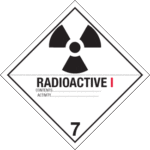
Category II Radioactive are substances with radiation at any point on the package surface does not exceed 500 µSv/h
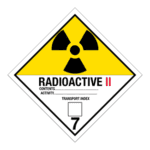
Category III Radioactive are substances with radiation at any point on the package surface that does not exceed 2 mSv/h
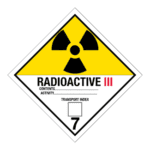
In Canada
This will be an informative guide to shipping class 7 radioactive materials in Canada but remember this is in no way a substitute for formal training. If training is required, please sign up for our certified online training courses.
Class 7 radioactive materials are a very unique hazardous material that are regulated by two federal agencies in Canada:
- Transport Canada, which is responsible for the transportation of dangerous goods (Transportation of Dangerous Goods Regulations, TDGR),
- Canadian Nuclear Safety Commission (CNSC), which is responsible for two regulations called the Packaging and Transport of Nuclear Substances Regulations, (2015, PTNSR) and Nuclear Substances and Radiation Devices Regulations.
These regulations can be found on the Justice Canada website. I have included the links at the bottom of this blog.
The TDGR will often defer to the PTNSR which may defer to the United Nations (UN) International Atomic Energy Agency (IAEA). For this blog, I will use the example of a smoke detector containing americium-241. This will fall into the category of excepted packages under IAEA section 423.
- “Radioactive material that is enclosed in or is included as a component part of an instrument or other manufactured article, may be classified under UN 2911, RADIOACTIVE MATERIAL, EXCEPTED PACKAGE — INSTRUMENTS or ARTICLES, provided that: (a) The dose rate at 10 cm from any point on the external surface of any unpackaged instrument or article is not greater than 0.1 mSv/h”
The TDGR and its Class 7 radioactive materials exemption found in part 1.43 will relieve you from most of its regulation as long as you satisfy the conditions found in the PTNSR. In regard to excepted packages, the TDGR only requires the consignment is accompanied by a document that includes the shipping name and UN number of the radioactive materials.
So, what about the conditions of the PTNSR?
Let’s use my example of smoke detectors. You may be exempted from the PTNSR altogether under the Application/Exception heading in the PTNSR. There are paragraphs A – P in this section and the one that is applicable to my example is paragraph F.
(f) “that is contained in a product for which no license is required under sections 6 to 8 of the Nuclear Substances and Radiation Devices Regulations following the sale of the product to an end user”
A look into the Nuclear Substances and Radiation Devices Regulation under section 6 smoke detector is listed and as long as you meet the requirements under that section no permit is required thus, I am exempted from the PTNSR.
Now, if you’re not the end user or your consignment has not been shipped to the end user, section 9 of the Nuclear Substances and Radiation Devices Regulations will not exempt you and you will need a license. Thus, not exempting you from the PTNSR.
So now what? Well, this means you must follow the PTNSR but good news, under section 25, the obligation for the PTNSR is sending you back to the TDGR and 1.45 exemption. Thus, requiring you to have a shipping document, and will require permitting from CNSC, has not been sold/shipped to the end user.
How about marks and labels? Under the TDGR 1.45 and PTNSR (28(2)(b)) you are exempted from labeling for grounds transport for exempted packages, but for air and sea shipments the PTNSR defers to the International Maritime Dangerous Goods (IMDG), for sea and the Technical Instructions for the Safe Transport of Dangerous Goods by Air (ICAO) and allows consignor and carriers to present shipment for ground transport utilizing the marking and labeling from those respective regulations, the labels below are from ICAO and IATA.
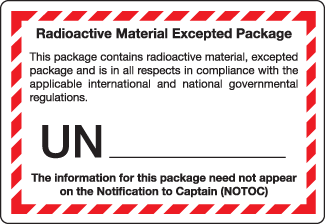
So, this brief example of shipping a smoke detector shows how you might have to perform a little bit of regulatory “acrobats” requiring you to jump from one regulation to another thus adding or subtracting requirements. The multitude of regulations from the TDGR to the PTNSR to the IAEA and back to the TDGR is enormous thus requiring you to have training and knowledge in the subject prior to shipping class 7’s, I hope this has been an eye-opening read.
Shipping radioactive materials can be a tricky business, but getting formal training and getting licenced can rest assure you that your shipment will arrive safely at its destination. Consider getting dangerous goods training from ICC.
Stay up to date and sign up for our newsletter!
We have all the products, services and training you need to ensure your staff is properly trained and informed.
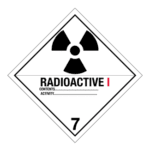 Radioactive Labels |
 Radioactive Material, Excepted Package Label |
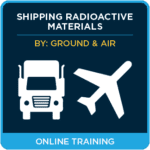 Shipping Radioactive Materials by Ground (49 CFR) and Air (IATA) Online Training |
References:
PTNSR: https://laws-lois.justice.gc.ca/eng/regulations/SOR-2015-145/index.html
TDGR: https://laws-lois.justice.gc.ca/eng/regulations/sor-2001-286/index.html
IAEA: https://www.iaea.org/publications/12288/regulations-for-the-safe-transport-of-radioactive-material
Nuclear Substances and Radiation Devices Regulations: https://laws-lois.justice.gc.ca/eng/regulations/SOR-2000-207/page-1.html#h-657860


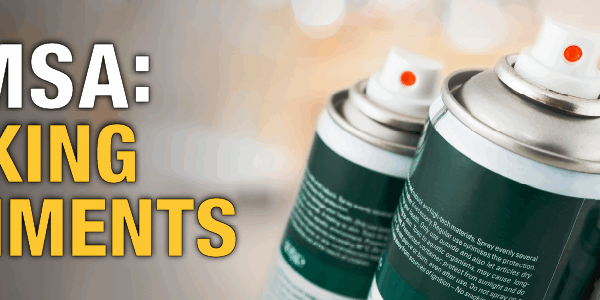
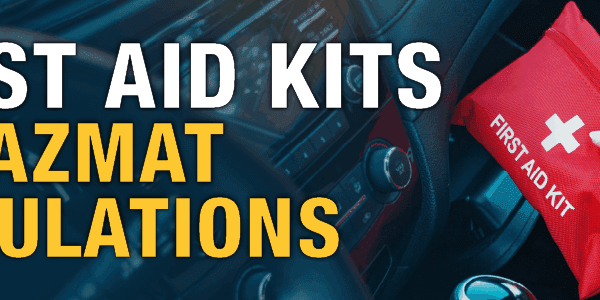



 ICC USA
ICC USA ICC Canada
ICC Canada